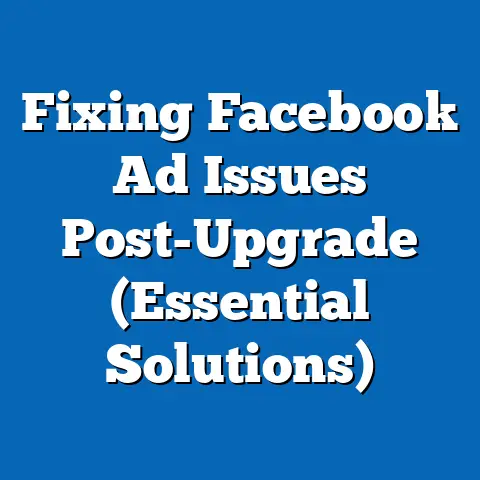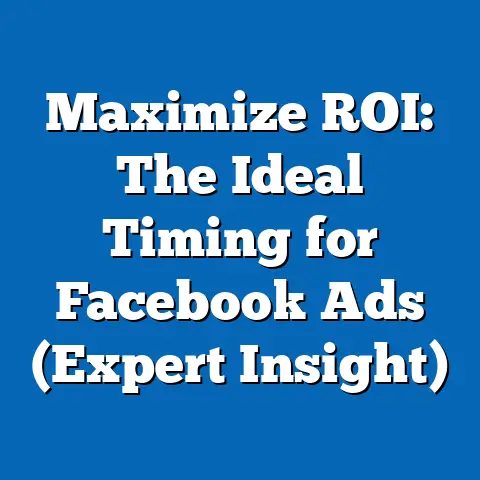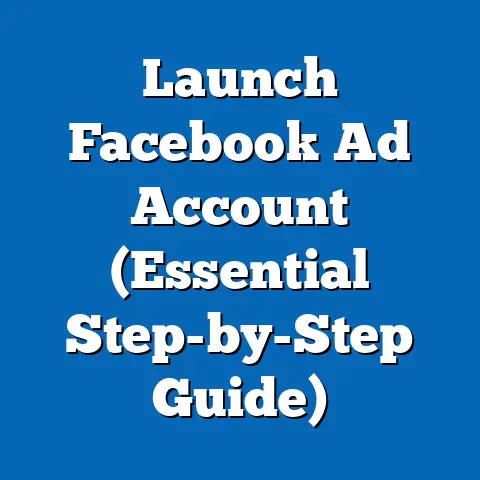Track Facebook Ads in GA4 (Unlock Powerful Insights)
In the rapidly evolving landscape of digital marketing, businesses face a persistent challenge: accurately tracking and analyzing the performance of their advertising campaigns across multiple platforms. Facebook Ads, as one of the most widely used advertising tools with over 2.9 billion monthly active users on the platform (Statista, 2023), plays a critical role in many companies’ marketing strategies. However, integrating and interpreting data from Facebook Ads into a unified analytics framework like Google Analytics 4 (GA4) often proves to be a complex and frustrating endeavor.
Marketers frequently struggle with fragmented data, inconsistent metrics, and a lack of clarity on how to attribute conversions across channels. This problem is compounded by the phasing out of third-party cookies and increasing privacy regulations, which have disrupted traditional tracking methods. Without a streamlined approach to tracking Facebook Ads in GA4, businesses risk misallocating budgets, misunderstanding customer behavior, and failing to optimize their return on investment (ROI).
Historical Context: The Evolution of Digital Advertising and Analytics
The rise of digital advertising in the late 1990s and early 2000s marked a transformative shift in how businesses connect with consumers. Early platforms like Google AdWords (launched in 2000) and later Facebook Ads (introduced in 2007) revolutionized marketing by offering targeted, measurable campaigns. However, tracking the effectiveness of these campaigns was initially rudimentary, relying on basic metrics like click-through rates (CTR) and impressions.
Google Analytics, first launched in 2005 after Google acquired Urchin Software, became the gold standard for web analytics, allowing businesses to track user behavior on their websites. Over the years, as digital advertising grew more sophisticated, so did the need for integrated analytics solutions that could bridge the gap between ad platforms and website performance data. Universal Analytics (UA), introduced in 2012, offered more robust tracking capabilities, but it still struggled with cross-platform attribution and mobile app tracking.
The launch of Google Analytics 4 in October 2020 represented a paradigm shift in analytics, driven by the need to adapt to a cookieless future and the growing importance of mobile and app-based interactions. GA4 introduced an event-based data model, replacing the session-based approach of UA, and emphasized machine learning to predict user behavior. This evolution was also a response to societal shifts, including heightened consumer awareness of data privacy and regulations like the General Data Protection Regulation (GDPR) and the California Consumer Privacy Act (CCPA).
Facebook Ads, meanwhile, evolved from a simple social media advertising tool into a powerhouse of granular targeting and retargeting capabilities. However, integrating Facebook’s data with external analytics platforms like GA4 has remained a challenge due to differences in attribution models and data reporting. Understanding this historical context is crucial for appreciating the complexities of modern ad tracking and the necessity of mastering tools like GA4 to stay competitive.
Defining Characteristics of GA4 and Facebook Ads Integration
Google Analytics 4 is built on a fundamentally different architecture compared to its predecessor, Universal Analytics. Its event-based tracking system allows for greater flexibility in capturing user interactions across websites and apps, making it well-suited for today’s multi-device, multi-platform user journeys. Additionally, GA4’s integration with Google Ads and other Google products offers seamless data flow for campaigns run within the Google ecosystem.
However, integrating non-Google platforms like Facebook Ads requires additional configuration, primarily through UTM parameters and manual data imports. UTM parameters (Urchin Tracking Module) are tags added to URLs that help GA4 identify the source, medium, and campaign associated with a user’s visit. When set up correctly, these parameters enable marketers to track Facebook Ads traffic within GA4, providing insights into user behavior post-click.
Facebook Ads, on the other hand, operates on a different attribution model, often prioritizing last-click or view-through conversions within its own platform. This discrepancy between Facebook’s reporting and GA4’s data-driven attribution model can lead to confusion when analyzing campaign performance. Understanding these defining characteristics—GA4’s flexibility and reliance on proper setup, alongside Facebook’s unique attribution logic—is essential for reconciling data and gaining actionable insights.
It’s also worth noting the diversity of use cases within this integration. Small businesses may focus on basic traffic and conversion tracking, while larger enterprises might leverage GA4’s advanced features like predictive analytics and audience segmentation to refine their Facebook Ads strategies. This nuance underscores the importance of tailoring tracking setups to specific business needs.
Societal and Business Implications of Effective Ad Tracking
The ability to track Facebook Ads in GA4 extends far beyond individual campaign optimization; it has broader implications for businesses and society at large. On a business level, accurate tracking enables companies to allocate marketing budgets more effectively, ensuring that resources are directed toward high-performing channels and audiences. According to a 2022 report by McKinsey, companies that leverage data-driven marketing are 1.5 times more likely to report revenue growth of over 10% compared to their peers.
Societally, the shift toward privacy-focused analytics reflects a growing demand for transparency in how consumer data is collected and used. GA4’s emphasis on first-party data and consent-based tracking aligns with these expectations, helping businesses build trust with their audiences. However, the complexity of integrating platforms like Facebook Ads into GA4 also highlights a digital divide: businesses with the resources and expertise to navigate these tools gain a competitive edge, while smaller players may struggle to keep up.
Moreover, the insights derived from tracking Facebook Ads in GA4 can influence broader cultural trends. For instance, understanding which demographics respond to specific ad creatives can inform content strategies that resonate with diverse audiences, shaping how brands communicate in an increasingly fragmented digital space. At the same time, missteps in data interpretation or over-reliance on certain metrics can perpetuate biases or exclude underrepresented groups, underscoring the need for ethical data practices.
Step-by-Step Guide to Tracking Facebook Ads in GA4
1. Setting Up UTM Parameters for Facebook Ads
To track Facebook Ads in GA4, the first step is to create consistent UTM parameters for each campaign. These parameters should include source (e.g., “facebook”), medium (e.g., “cpc” for cost-per-click), and campaign name (e.g., “summer_sale_2023”). This can be done manually in the Facebook Ads Manager by adding UTM codes to the destination URLs or by using tools like Google’s Campaign URL Builder for efficiency.
Consistency in naming conventions is critical to avoid data fragmentation in GA4. For example, using “fb” in one campaign and “facebook” in another will result in split data, making analysis more difficult. Once set up, these parameters will allow GA4 to categorize incoming traffic from Facebook Ads accurately.
2. Verifying Data in GA4
After launching the campaign, navigate to GA4’s “Acquisition” reports to verify that traffic from Facebook Ads is being tracked correctly. Under “Traffic Acquisition,” you should see sessions attributed to the source and medium specified in your UTM parameters. If data appears missing or miscategorized, double-check the UTM setup in Facebook Ads Manager and ensure there are no redirects stripping the parameters.
It’s also advisable to set up custom events in GA4 for specific actions (e.g., form submissions or purchases) that align with your campaign goals. This provides deeper insights into user behavior beyond clicks and sessions.
3. Reconciling Attribution Models
One of the biggest challenges in tracking Facebook Ads in GA4 is the difference in attribution models. Facebook often credits conversions based on a 28-day click or 1-day view window, while GA4 uses a data-driven attribution model that distributes credit across multiple touchpoints. To address this, consider using GA4’s “Model Comparison” tool to understand how different attribution models impact conversion reporting.
Marketers should also be aware of potential double-counting if conversions are tracked in both platforms without deduplication. A best practice is to use GA4 as the primary source of truth for website conversions, while referencing Facebook Ads Manager for ad-specific metrics like impressions and reach.
4. Leveraging GA4’s Advanced Features
GA4 offers powerful tools like audience segmentation and funnel analysis that can enhance insights from Facebook Ads data. For instance, creating a custom audience in GA4 based on users who engaged with a specific Facebook campaign allows for retargeting or lookalike audience creation in Facebook Ads Manager. Similarly, funnel reports can reveal drop-off points in the user journey, helping optimize ad creatives or landing pages.
Machine learning features in GA4, such as predictive metrics for purchase probability, can also inform bid adjustments and budget allocation for future Facebook campaigns. These advanced capabilities highlight the value of integrating data across platforms.
Technological, Economic, and Cultural Factors Influencing Tracking Challenges
Technological Factors
The transition to GA4 and the integration of platforms like Facebook Ads are shaped by broader technological trends, including the decline of third-party cookies and the rise of server-side tracking. Apple’s App Tracking Transparency (ATT) framework, introduced in 2021, further complicates tracking by requiring explicit user consent for data collection on iOS devices. These changes have forced marketers to rely more heavily on first-party data and tools like GA4’s enhanced measurement features.
Additionally, discrepancies in how platforms handle data—such as Facebook’s aggregated event measurement for iOS users—create gaps in tracking accuracy. Staying abreast of these technological shifts is essential for maintaining effective ad tracking workflows.
Economic Factors
Economically, the cost of advertising on platforms like Facebook has risen significantly, with average cost-per-click (CPC) increasing by 17% year-over-year in 2022 (WordStream, 2023). This trend places greater pressure on businesses to justify ad spend through precise tracking and optimization. GA4’s ability to provide detailed ROI insights can be a game-changer, particularly for small and medium-sized enterprises (SMEs) operating on tight budgets.
At the same time, the economic disparity between large corporations with dedicated analytics teams and smaller businesses with limited resources highlights an uneven playing field. Democratizing access to tools and education around GA4 and ad tracking is crucial for leveling this disparity.
Cultural Factors
Culturally, the growing emphasis on privacy and data ethics influences how businesses approach ad tracking. Consumers are increasingly wary of intrusive advertising, with 74% expressing concern over how their data is used (Pew Research Center, 2022). GA4’s focus on anonymized data and consent management reflects this cultural shift, but it also requires marketers to balance personalization with privacy.
Furthermore, generational differences in technology adoption impact how audiences engage with Facebook Ads. Younger users, such as Gen Z, may prioritize platforms like Instagram (owned by Meta) over Facebook, necessitating tailored campaigns and tracking setups in GA4 to capture platform-specific behavior.
Comparative Analysis: GA4 vs. Facebook Ads Manager Reporting
While both GA4 and Facebook Ads Manager provide valuable insights, they serve different purposes and often yield divergent results due to their unique methodologies. GA4 offers a holistic view of user behavior across touchpoints, making it ideal for understanding the full customer journey. In contrast, Facebook Ads Manager focuses on ad-specific metrics, such as cost-per-impression and engagement rates, within its ecosystem.
A key difference lies in attribution: GA4’s data-driven model may attribute a conversion to an earlier touchpoint (e.g., an organic search), while Facebook might claim credit for the same conversion due to a later ad interaction. This discrepancy can lead to inflated or deflated performance metrics depending on the platform consulted. Marketers must therefore adopt a blended approach, using GA4 for website and cross-channel insights while leveraging Facebook Ads Manager for granular campaign data.
Another point of comparison is customization. GA4 allows for extensive event tracking and custom dimensions, offering flexibility that Facebook’s reporting lacks. However, Facebook provides real-time data and demographic breakdowns that are more immediate and detailed than GA4’s standard reports. Recognizing these strengths and limitations is key to forming a comprehensive view of campaign performance.
Nuances and Diversity in Ad Tracking Needs
It’s important to acknowledge that not all businesses or campaigns have the same tracking requirements. A local retailer running a single Facebook Ads campaign may only need basic traffic and conversion data in GA4, while a global e-commerce brand might require complex funnel analysis and cross-platform attribution. Similarly, industries like healthcare or finance, which face stricter data privacy regulations, must navigate additional compliance challenges when setting up tracking.
Demographic diversity also plays a role. Campaigns targeting older audiences may see lower engagement on Facebook compared to platforms like LinkedIn, affecting how data appears in GA4. Conversely, younger audiences might skew toward visual platforms, requiring marketers to adjust UTM parameters and tracking priorities accordingly. These nuances highlight the importance of a tailored approach to ad tracking rather than a one-size-fits-all solution.
Implications for Business Strategy and Workplace Dynamics
Business Strategy
Effective tracking of Facebook Ads in GA4 has far-reaching implications for business strategy. By identifying high-performing audience segments and campaign elements, companies can refine their marketing efforts, reduce waste, and improve customer acquisition costs. For example, a 2023 study by Forrester found that businesses using integrated analytics tools like GA4 reported a 20% improvement in marketing efficiency.
Strategically, this data can also inform product development and customer experience initiatives. Understanding which ads drive not just clicks but meaningful engagement (e.g., time on site or repeat purchases) can guide decisions on messaging, pricing, and user interface design. In a competitive digital marketplace, such insights are invaluable for maintaining a competitive edge.
Workplace Dynamics
In the workplace, the adoption of GA4 and integrated ad tracking necessitates upskilling employees in analytics and data interpretation. Marketing teams must collaborate closely with data analysts to ensure accurate setup and analysis, fostering cross-functional communication. Additionally, the complexity of tools like GA4 may require hiring specialized talent or outsourcing to agencies, impacting organizational structure and budgets.
At the same time, the democratization of data through accessible platforms like GA4 empowers non-technical staff to engage with analytics, potentially flattening hierarchies and encouraging data-driven decision-making at all levels. This shift can enhance workplace innovation but also introduces challenges in maintaining data literacy across diverse teams.
Forward-Looking Insights: The Future of Ad Tracking
As digital advertising and analytics continue to evolve, several trends are likely to shape the future of tracking Facebook Ads in GA4. First, the ongoing push for privacy will drive greater reliance on first-party data and contextual advertising, requiring even tighter integration between platforms. GA4’s machine learning capabilities may become more central, offering predictive insights that preemptively optimize campaigns.
Second, the rise of artificial intelligence (AI) in marketing tools could automate much of the setup and analysis process, reducing the manual effort needed to track ads across platforms. However, this also raises questions about data accuracy and the potential for over-reliance on automated systems. Marketers will need to balance AI-driven insights with human judgment to ensure strategic alignment.
Finally, as new social media platforms emerge and user behavior shifts, the need for flexible, cross-platform analytics will only grow. GA4’s adaptability positions it well for this future, but its effectiveness will depend on continuous updates and user education. While uncertainties remain—such as the impact of future privacy laws or technological disruptions—the trajectory points toward increasingly integrated, user-centric analytics solutions.
Conclusion
Tracking Facebook Ads in GA4 is a powerful way to unlock insights into campaign performance, user behavior, and marketing ROI, but it comes with significant challenges rooted in technological, economic, and cultural factors. By understanding the historical context of digital advertising analytics, mastering the setup process, and reconciling discrepancies between platforms, businesses can harness GA4 to drive data-driven decisions. The societal implications of this capability—from enhanced consumer trust to the risk of digital inequity—underscore the importance of ethical and inclusive practices in ad tracking.
Looking ahead, the future of ad tracking will likely be shaped by privacy regulations, AI advancements, and evolving user expectations, presenting both opportunities and uncertainties. For now, marketers must focus on building robust tracking frameworks in GA4, tailoring strategies to their unique needs, and fostering a culture of continuous learning. In doing so, they can not only optimize their Facebook Ads campaigns but also contribute to a more transparent and effective digital marketing ecosystem.






